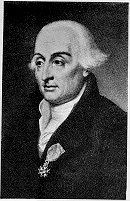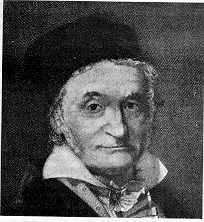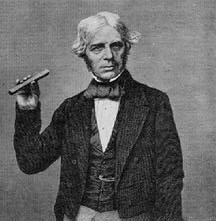 You may read in The Medieval Machine: The Industrial Revolution of the Middle Ages, by Jean Gimpel, 1977, that, in the 12th century (A.D.), began what should be called THE MECHANICAL INDUSTRIAL REVOLUTION. Monks -- desiring to raise their food and other needs, yet have time for prayer and meditation -- were given special permission by the Pope to read pagan texts showing how to build watermills and windmills. In this century and the next, these mills spread across Europe. (The Domesday Book of 1086 lists 5624 water-wheel driven mills in England south of Trent, or about one mill for each 400 persons.) Clearly, further extension of these mills would have eliminated much of the slavepower then existing, but "the lesson" was still not obvious enough. (The Amish are still "stuck" in The Mechanical Revolution, refusing to adopt the benfits of succeeding Revolutions.)
You may read in The Medieval Machine: The Industrial Revolution of the Middle Ages, by Jean Gimpel, 1977, that, in the 12th century (A.D.), began what should be called THE MECHANICAL INDUSTRIAL REVOLUTION. Monks -- desiring to raise their food and other needs, yet have time for prayer and meditation -- were given special permission by the Pope to read pagan texts showing how to build watermills and windmills. In this century and the next, these mills spread across Europe. (The Domesday Book of 1086 lists 5624 water-wheel driven mills in England south of Trent, or about one mill for each 400 persons.) Clearly, further extension of these mills would have eliminated much of the slavepower then existing, but "the lesson" was still not obvious enough. (The Amish are still "stuck" in The Mechanical Revolution, refusing to adopt the benfits of succeeding Revolutions.)
This MECHANICAL INDUSTRIAL REVOLUTION (described above) waned with "The Black Death" (bubonic plague), peaking in 1348. The Black Death was caused by the dearth of cats to control the rat population. For centuries, the superstitious had killed cats, alleging them to be the "familiars" of witches. (Cats' eyes ![]() can catch any light in a dark room or cave, lighting up when nothing else does. Also, in cold climes, stroking a cat invokes static electricity, and the sparks scintillate in the dark.) One Pope even advocated exterminating cats. So, by the middle of the 14th century, the dearth of cats allowed the rat population to multiply to epidemic proportions. The rats
can catch any light in a dark room or cave, lighting up when nothing else does. Also, in cold climes, stroking a cat invokes static electricity, and the sparks scintillate in the dark.) One Pope even advocated exterminating cats. So, by the middle of the 14th century, the dearth of cats allowed the rat population to multiply to epidemic proportions. The rats ![]() carried fleas. And the fleas carried the Plague. In 5 years, the
Plague killed 25 million, 1/3 of Europe's Population. In some regions, 50% of the population died in "The Black Death". Many regions lacked blacksmiths, coopers, wheelrights, other craftsmen.
carried fleas. And the fleas carried the Plague. In 5 years, the
Plague killed 25 million, 1/3 of Europe's Population. In some regions, 50% of the population died in "The Black Death". Many regions lacked blacksmiths, coopers, wheelrights, other craftsmen.
Training had been oral. The Church now allowed more general reading of "pagan" books, initiating The Renaissance. (Tell this story to teen-agers who "want to work with their hands", but ask why they need reading skills!)
 In 1776, (English) James Watt installed two of his steam engines, initially used in mining. This same year, John Wilkinson used a steam engine to activate an efficient blast furnace for iron-making. By the end of the century, there were 24 blast furnaces in England. THE THERMODYNAMIC INDUSTRIAL REVOLUTION had begun. It exploded via timing explosions of gasoline-engines in the "automotive" revolution in America and Europe
In 1776, (English) James Watt installed two of his steam engines, initially used in mining. This same year, John Wilkinson used a steam engine to activate an efficient blast furnace for iron-making. By the end of the century, there were 24 blast furnaces in England. THE THERMODYNAMIC INDUSTRIAL REVOLUTION had begun. It exploded via timing explosions of gasoline-engines in the "automotive" revolution in America and Europe
 In 1788, (French) Joseph Louis Lagrange (1736-1813) published his Mechanique analytique, which used work of Euler and the calculus of variations to present an alternative to Newton's laws of physics. From this point on, enough mathematics became available to "ripen" the Mechanical Industrial Revolution, to further THE THERMODYNAMIC INDUSTRIAL REVOLUTION and to prepare for THE ELECTRICAL INUDUSTRIAL REVOLUTION.
In 1788, (French) Joseph Louis Lagrange (1736-1813) published his Mechanique analytique, which used work of Euler and the calculus of variations to present an alternative to Newton's laws of physics. From this point on, enough mathematics became available to "ripen" the Mechanical Industrial Revolution, to further THE THERMODYNAMIC INDUSTRIAL REVOLUTION and to prepare for THE ELECTRICAL INUDUSTRIAL REVOLUTION.
(English) George Greene (1793-1841) was a self-taught miller. His Essay on the mathematical analysis to the theories of electricity and magnetism introduced many powerful tools to pure mathematics and to applied mathematics. In particular, Greene created the concept of potential, from which a force can be derived. (And "Greene's Function" was used in the 1940's by (American) Richard Feynman (1918-1988) in developing an alternative to the quantum theory approaches of (German) Werner Heisenberg (1901-1976) and (Austrian) Erwin Schrödinger(1887-1961.)
1821 saw publication of Cours d'analyse de l'Ecole Polytechnique, by Augustin Marie Cauchy (1789-1857), putting "calculus" on a firm foundation, a major step in resolving "The Second Crisis in The Foundations of Mathematics". Cauchy defined irrational numbers such as √2 as an unending sequence of rational numbers, each as simple as "an Egyptian fraction".
(1789-1857), putting "calculus" on a firm foundation, a major step in resolving "The Second Crisis in The Foundations of Mathematics". Cauchy defined irrational numbers such as √2 as an unending sequence of rational numbers, each as simple as "an Egyptian fraction".
 (German) Karl Friedrich Gauss (1777-1855) is considered to be "the greatest of mathematicians". But in 1833, Gauss collaborated with physicist Wilhelm Weber to develop an improvement on Samuel Morse's electric telegraph. The applied mathematics Gauss developed for this, along with that of George Greene, prepared the way for the great work of Clerk-Maxwell and THE ELECTRICAL INDUSTRIAL REVOLUTION.
(German) Karl Friedrich Gauss (1777-1855) is considered to be "the greatest of mathematicians". But in 1833, Gauss collaborated with physicist Wilhelm Weber to develop an improvement on Samuel Morse's electric telegraph. The applied mathematics Gauss developed for this, along with that of George Greene, prepared the way for the great work of Clerk-Maxwell and THE ELECTRICAL INDUSTRIAL REVOLUTION.
 In 1845, (English) Michael Faraday (1791-1867) discovered diamagnetism and paramagnetism, and related light to magnetism by discovering that a magnetic field affects polarization of light in crystals. So Faraday proposef that light may be waves of electromagnetism.
In 1845, (English) Michael Faraday (1791-1867) discovered diamagnetism and paramagnetism, and related light to magnetism by discovering that a magnetic field affects polarization of light in crystals. So Faraday proposef that light may be waves of electromagnetism.
 In 1855, (Scot) William Thomson (knighted as Lord Kelvin) developed a theory of transmission of electric signals through submarine cables, and later directed the laying of the Trans-Atlantic Cable System. A big advance towards THE ELECTRICAL INDUSTRIAL REVOLUTION.
In 1855, (Scot) William Thomson (knighted as Lord Kelvin) developed a theory of transmission of electric signals through submarine cables, and later directed the laying of the Trans-Atlantic Cable System. A big advance towards THE ELECTRICAL INDUSTRIAL REVOLUTION.
 In 1860, (Scot) James Clerk Maxwell (1831-1879) -- independently of work by (German) Ludwig Boltzmann (1844-1906) -- developed study of the statistical properties of molecules in a gas -- a great advance in THE THERMODYNAMIC INDUSTRIAL REVOLUTION. (Texts today speak of "Maxwell-Boltzmann" statistics. It was shifting from these to "Fermi-Dirac statistics" and "Einstein Bose statistics", which initiated one of the greatest advances in quantum theory.)
In 1860, (Scot) James Clerk Maxwell (1831-1879) -- independently of work by (German) Ludwig Boltzmann (1844-1906) -- developed study of the statistical properties of molecules in a gas -- a great advance in THE THERMODYNAMIC INDUSTRIAL REVOLUTION. (Texts today speak of "Maxwell-Boltzmann" statistics. It was shifting from these to "Fermi-Dirac statistics" and "Einstein Bose statistics", which initiated one of the greatest advances in quantum theory.)
1861-1865, American Civil War (a.k.a. War Between The States), over issue of Slavery and States' Rights -- a war between two Industrial Revolutions: THE THERMODYNAMIC INDUSTRIAL REVOLUTION of "The North" and THE MECHANICAL INDUSTRIAL REVOLUTION of "The South".
 In 1882, (American) Thomas Edison's Pearl Street Station lighted New York City -- THE ELECTRICAL INDUSTRIAL REVOLUTION had begun. Actually, it
was an ELECTRO-MECHANICAL INDUSTRIAL REVOLUTION -- ELECTRIC CIRCUITS CONTROLLED BY MECHANICAL
MEANS DATING BACK TO THE MECHANICAL REVOLUTION.
In 1882, (American) Thomas Edison's Pearl Street Station lighted New York City -- THE ELECTRICAL INDUSTRIAL REVOLUTION had begun. Actually, it
was an ELECTRO-MECHANICAL INDUSTRIAL REVOLUTION -- ELECTRIC CIRCUITS CONTROLLED BY MECHANICAL
MEANS DATING BACK TO THE MECHANICAL REVOLUTION.
In 1883, (Irish) physicist George Francis Fitzgerald (1851-?) noted that Maxwell's theory of electromagnetic waves indicates that these waves can be generated by PERIODIC VARIATION OF AN ELECTRIC CURRENT. This same year -- despite general scepticism among physicists -- (German) Heinrich Hertz (1857-1894) used an induction coil to generate and detect radio waves, as Maxwell and Fitzgerald had predicted.
 In 1902, using antenna of his own design, (Italian) Gugliermo Marconi (1874-1937) transmitted radio signals across the Atlantic Ocean, from Cornwall in Britain, to Newfoundland in Canada. THE ELECTRONIC INDUSTRIAL REVOLUTION was about to begin. (ELECTRONICS is THE CONTROL OF ELECTRICITY BY ELECTRICITY, rather than by MECHANICAL means, such as RELAYS and MECHANICAL SWITCHES.)
In 1902, using antenna of his own design, (Italian) Gugliermo Marconi (1874-1937) transmitted radio signals across the Atlantic Ocean, from Cornwall in Britain, to Newfoundland in Canada. THE ELECTRONIC INDUSTRIAL REVOLUTION was about to begin. (ELECTRONICS is THE CONTROL OF ELECTRICITY BY ELECTRICITY, rather than by MECHANICAL means, such as RELAYS and MECHANICAL SWITCHES.)
In 1920, the first radio station, KDKA in Pittsburgh, PA, began broadcasting -- THE ELECTRONIC INDUSTRIAL REVOLUTION had begun.
We are now going into the NANO-PHOTONIC INDUSTRIAL REVOLUTION -- nanines the size of ATOMS ("nano-level"), photines controlled by PHOTONS rather than ELECTRONS.